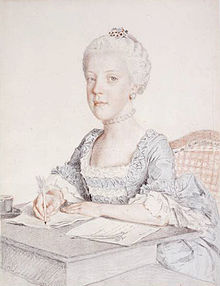Archduchess Maria Johanna Gabriela of Austria
| Archduchess Maria Johanna Gabriela of Austria | |||||
|---|---|---|---|---|---|
 Portrait by Jean-Étienne Liotard, 1762 | |||||
| Born | 4 February 1750 Hofburg Palace, Vienna, Archduchy of Austria, Holy Roman Empire | ||||
| Died | 23 December 1762 (aged 12) Hofburg Palace, Vienna, Archduchy of Austria, Holy Roman Empire | ||||
| Burial | |||||
| |||||
| House | Habsburg-Lorraine | ||||
| Father | Francis I, Holy Roman Emperor | ||||
| Mother | Maria Theresa | ||||
Archduchess Maria Johanna of Austria (German: Maria Johanna Gabriele Josefa Antonia; 4 February 1750 – 23 December 1762) was an Archduchess of Austria as the eleventh child of Empress Maria Theresa and Francis I, Holy Roman Emperor. She was originally meant to marry Ferdinand I of the Two Sicilies, however, the marriage plans were never finalised due to Maria Johanna's death due to smallpox.[1]
Childhood[edit]
Maria Johanna was born on 4 February 1750 at the Hofburg Palace in Vienna, Austria, as the eleventh child and eighth daughter of Francis I, Holy Roman Emperor and Empress Maria Theresa. She was raised in the Kindskammer with her many siblings, though she was particularly close with her sister Maria Josepha,[citation needed] whom was born a year after Maria Johanna in 1751. The two were educated together and had the same tutors.[2][3]

Maria Johanna strictly studied Latin, French, Italian, Greek, Spanish, German, English, history, geography, land surveying, mathematics, and theology—from the age of three.[4] She was also taught how to dance and sing, and was known to have excelled at these subjects.[citation needed] She often gave musical performances, as she loved to sing.[citation needed] She also loved to act.
Additionally, Maria Johanna and her sisters were highly educated in dance and singing. While her brothers were taught to play different instruments, Maria Johanna and her sisters were given singing lessons. A special theatre was built at the Schönbrunn Palace, specially for the children; Maria Johanna and her siblings gave frequent musical performances. All in all, Maria Johanna and her sister Maria Josepha "developed satisfactory, worked hard at their lessons and were involved in numerous festivities in which they participated enthusiastically."[3]
Betrothal[edit]

Maria Theresa and King Charles III of Spain both agreed that Maria Johanna's sister, Maria Amalia, would marry Charles' son Ferdinand III, King of Sicily and IV of Naples, however, Charles later wanted to break off the engagement due to Maria Amalia being five years older than Ferdinand. Since Maria Johanna was just one year older than Ferdinand, she was betrothed to him instead.[5]
Death[edit]

In the second half of the eighteenth-century, smallpox was ravaging through the Holy Roman Empire. Leopold Mozart, father of Wolfgang Amadeus Mozart, wrote that "in the whole of Vienna, nothing was spoken of except smallpox. If 10 children were on the death register, 9 of them had died from smallpox."[6] In December 1762, Maria Johanna caught the disease and died on 23 December; her painful death was described by her sister-in-law Isabella.[7] Her mother, Maria Theresa, found comfort in the fact that before her death Maria Johanna made a complete confession of her sins to a Catholic priest. Maria Theresa wrote to Maria Johanna's sister, Maria Christina:
Your sister has confessed her sins for three-quarters of an hour, with a preciseness, repentance and devotion which brought her confessor to tears; since then, she is very weak. I cannot thank the loving God enough that he gives me this comfort; I give her completely into his hand and expect that her destiny cannot be anything than happy."[7]
Aftermath[edit]
The loss of Maria Johanna to smallpox, along with that of other members of the family, contributed to Maria Theresa's decision to have the younger members of her family inoculated, and the subsequent acceptance of smallpox inoculation in Austria.[8]
Ancestry[edit]
References[edit]
- ^ "Kaisergruft: Johanna Gabriela". Kaisergruft. kaisergruft.at. Archived from the original on 5 January 2009. Retrieved 29 April 2012.
- ^ Iby 2009, p. 29.
- ^ a b Iby 2009, p. 57.
- ^ Iby 2009, p. 32.
- ^ Hopkins, Donald R. (2002). The greatest killer: smallpox in history, with a new introduction. University of Chicago Press. p. 63. ISBN 0-226-35168-8.
- ^ Magiels 2010, p. 21.
- ^ a b Stollberg-Rilinger 2017, p. 507.
- ^ Stollberg-Rilinger 2017, p. 507-514.
- ^ Genealogie ascendante jusqu'au quatrieme degre inclusivement de tous les Rois et Princes de maisons souveraines de l'Europe actuellement vivans [Genealogy up to the fourth degree inclusive of all the Kings and Princes of sovereign houses of Europe currently living] (in French). Bourdeaux: Frederic Guillaume Birnstiel. 1768. p. 1.
Bibliography[edit]
- Iby, Elfriede (2009). Maria Theresa: Biography of a Monarch (1st ed.). Schloß Schönbrunn. ISBN 978-3-901568-57-2.
- Magiels, Geerdt (2010). From Sunlight to Inlight (1st ed.). VUBPrint. ISBN 9789054876458.
- Mahan, Jabez Alexander (1932). Maria Theresa of Austria. New York: Crowell.
- Stollberg-Rilinger, Barbara (2017). Maria Theresia: Die Kaiserin in ihrer Zeit. Eine Biographie. Munich: C.H. Beck. ISBN 978-3-406-69748-7.
External links[edit]
- 1750 births
- 1762 deaths
- 18th-century Austrian people
- 18th-century Austrian women
- House of Habsburg-Lorraine
- Deaths from smallpox
- Austrian princesses
- Burials at the Imperial Crypt
- Burials at St. Stephen's Cathedral, Vienna
- Infectious disease deaths in Austria
- Daughters of emperors
- Children of Maria Theresa
- Royalty who died as children
- Daughters of kings
- Daughters of queens regnant
